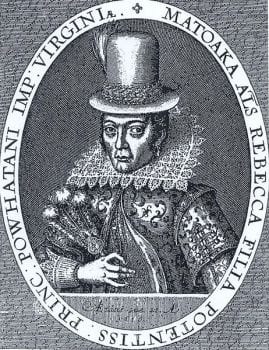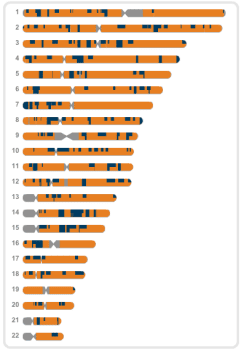Editor’s note: Some of the tools described in this post no longer reflect the current 23andMe product offerings.
Every family has its legends.
Maybe it’s a story about how they’re descended from a passenger on the Mayflower, a Confederate soldier or Charlemagne.

Pocahontas.
Of all the classic American family legends, stories of a Native American ancestor are among of the most common. Many times there’s a well-documented link to a Native forbear: Two First Ladies (Edith Wilson and Nancy Reagan) and one Duchess of Windsor (Wallis Simpson) are proven descendants of Pocahontas.
Other times, the evidence amounts to little more than vague tales about a rugged pioneer and a Cherokee princess. (Learn what’s wrong with that scenario here.)
Now 23andMe customers who are curious about whether they may have Native American ancestors can look for evidence of it in their genes.
The Native American Ancestry Finder uses some existing 23andMe features – Ancestry Painting, Maternal Line and Paternal Line – to look for genetic signatures that are likely to have come from a Native American ancestor.
The Maternal Line and Paternal Line elements of the Finder are pretty straightforward; certain mitochondrial DNA (maternal) and Y chromosome (paternal) haplogroups are often found among Native Americans.
These include mitochondrial haplogroups A2, B2, C1, D1 and X2a – which are found exclusively among Native Americans. People in some other branches of the A, B, C and D haplogroups may also have Native American ancestry, but their maternal lines could also trace to Asia. On the paternal side, only Q3 is exclusive to Native Americans, though anyone with a Y chromosome in the C, C3 or Q haplogroup could conceivably have Native American forbears.

An example of a Native American’s ancestry painting.
The part of the Finder that uses Ancestry Painting to find evidence for Native American forbears is a little more complicated. It relies on the fact that people of full Native American descent have Ancestry Paintings that are consistently about 75% orange (Asian) and 25% blue (European).
This is due to the fact that Native Americans are ultimately descended from populations that lived in northern and central Asia about 15,000 to 20,000 years ago, and the fact that those regions are intermediate between the reference populations that Ancestry Painting classifies as fully Asian (Japanese and Chinese) and fully European (European-Americans living in Utah).
Then the Finder compares your Ancestry Painting proportions to a table that contains the results of an extensive series of simulations that we performed to determine what would happen to that three-to-one Asian/European proportion over the generations if a Native American and a partner of all-European descent had a child who then reproduced with another all-European partner, and so on. We did the same analysis for a Native American marrying into an all-Asian pedigree.
Unfortunately, partly due to inadequate sampling of Africa’s genetic diversity, this method cannot yet establish Native American ancestry for African Americans.
We found that it takes at least five generations after the appearance of a single Native American in an otherwise all- European pedigree for the percentage of Asian (orange) DNA to reach zero. In an otherwise all-Asian pedigree that process is much faster – in two generations, the grandchild of that single Native American can have no trace of European in his or her Ancestry Painting.
There are, of course, plenty of Eurasian populations that also have blue-and-orange Ancestry Paintings. So the Native American Ancestry Finder performs a second analysis that can distinguish people of South Asian, Central Asian, Middle Eastern and Ashkenazi descent from those with Native American ancestry.
Unfortunately, there is still some uncertainty when it comes to distinguishing people with Native American ancestry.
It’s still a work in progress – that’s what Labs are all about. But we hope customers will help us by trying out the Native American Ancestry Finder and letting us know if anything doesn’t mesh with what they know about their genealogy.
You can also contribute by taking the “Where Are You From?” survey in 23andWe.




